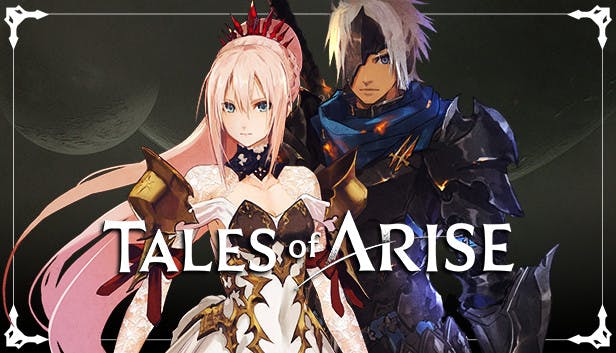It has been a little bit since the last Tales of game, with Berseria in 2016. Actually the longest gap between “main” releases in this series. So I was pretty excited for this one. I usually like the Tales of games, though I haven’t played all of them. This looked decent from what I saw pre-release.
Not much else to say in an intro… Let’s just go!
Developer and Publisher: Bandai Namco Games
Release date: September 10th 2021
Platforms: PC, PS4, Xbone, PS5, Xbox X/S (PC version played)
Genre: Console-style Action-RPG
You know, I find it funny how everyone freaked out at FF13 being a hallway simulator, but so many JRPGs nowadays are just that, or even simpler ones with even less exploration with menus to get to different areas, but people seem totally fine with that (and honestly I am too if the combat and leveling is still fun). Just a weird thing I noticed. Tales of Arise is one of these very linear JRPGs with not much exploration, but it has the Tales stuff going as far as combat and other such things.
You play as Alphen and his companions on a quest to save the Dahnan people from the oppression of the Renan people. The people from Rena actually come from a space station that’s in-between planet Dahna and planet Rena, though both planets are actually very close by. 300 years ago, Rena attacked Dahna, enslaving the Dahnan populace since. Not specifically for their labor, but more to drain their astral energy using a crystal on their hand. The Dahnan’s can’t really fight back because Renans are powerful magic users, they have equipment, and they have literal laser-shooting spaceships… so resistance is basically futile. Alphen is a dude wearing an iron mask (which can’t be taken off) who lost his memory, and has lived as a slave for the last year. After some shit happens he saves Shionne, a Renan who was imprisoned and being transported on a train, and he teams up with the local resistance group. Shionne is special because she actually hurts anyone who touches her for some reason, and also she has a Master Core, which puts her at the same level as the Renan lords. And Alphen, in addition to having no memory and wearing an iron mask, can’t feel pain, so he’s the only person actually able to touch Shionne, and use the Blazing Sword that comes out of her Master Core, basically a very hot sword that shoots waves of fire.
Shionne’s goal is to kill all the Renan lords for a reason she doesn’t explain until later. It ends up going in line with Alphen’s goal as he joins the resistance to liberate Dahna from Renan rule, and due to the ability to use the Blazing Sword, this gives them the power to be able to fight the Renans at a somewhat even level. So they go to different area of the world, team up with new people, find out how the oppression of Dahnan citizens happens in the local area and try to save them from the current lord. Sometimes they’re more to it than meets the eye, of course. But it becomes clear, as you go, that there’s something more going on behind the scenes, and the true meaning behind Shionne’s actions. It’s a pretty decent plot overall though there’s a smal twist in there that’s… fine, it works, but it’s a bit disappointing. I did like some of the characters, though I was surprised that you don’t get a full complement of 8 characters to fill up the party edit screen. One thing I do find weird is how Renans have fucking laser-shooting spaceships, but the majority of their soldiers based in Dahna are equipped with swords and shields. Only some of them have guns. It’s a weird technological discrepancy.
Quick note on translation… it’s pretty awful. Ignoring the overall accuracy of the translation (it’s fine, a lot of sentences are incorrect but still… somewhat valid, it still mostly follows the spirit of it even if the translation itself is incorrect compared to the japanese voice acting), every other line of dialogue is covered in spelling errors and grammar mistakes. They just did not spellcheck the script, at all. Pretty terrible work overall.
So gameplay… The game flow is as simple as it gets for a console-style RPG. You walk from one end of the current map to the other, and the plot continues. There’s occasional splits in the straight path, usually that lead to resources you can grab and treasures. There’s occasional splits in the path that lead to later parts of the game, you’re generally prevented from taking those splits early (or they lead to nothing). You do have the option to fast travel from anywhere to anywhere that the game considers a fast travel point, this is useful later down the line where you have more sidequests. There’s enemies all over the place, if you touch one of them you start a battle with that monster and any monsters in fairly close proximity (it’s actually possible to bait single enemies for easier battles with fewer enemies at once, or get a larger group of enemies at once). Monsters are called Zeugles here… not sure why. Towns are pretty straightforward, there’s a few NPCs with nothing of note to say and an inn, which is where the shops will be. There’s not much to do there outside of walking to the next part of the story, or looking at the minimap to see if there’s anyone with a sidequest to give you. Oh and sometimes as you walk around you can press RB to see a quick conversation between some of the characters, as per normal Tales stuff… it’s not super important to do overall, it just adds a bit of extra characterization to some of these people.
Combat is similar to other Tales games but not identical. You have a circle area that you can move around freely. You attack with the right shoulder button which is weird, and dodge with the right trigger which is a bit weird. From the 4 face buttons, 3 are set to an arte (special attack), and one to jumping. You get different artes in the air of course. I dunno, the old system of a face button to attack and a face button for artes (based on directions) was fine. If you dodge in time, you get a short window to press the normal attack button to do a counter, which is just a bit stronger than a normal attack, about as strong as an arte. Attacks and artes pretty much link into each other naturally, and link into themselves too. A good arte can just be linked into itself for optimal damage. Each character plays a little bit differently, usually because of how their artes work (like Rimwell being a mage, having different ways to cast and store spells), or Kisara guarding instead of dodging. I just played as Alphen the whole way after trying everyone else once, he’s just easier to deal with. The other 3 characters in your party will be AI controlled, and generally they’re fine. You can set tactics on them (similar to FF12 gambits), so ones with healing spells will generally time them correctly. One important part of combat is items. Basically, as you progress, enemies just get wildly strong, mostly because they have a lot of HP, and your party won’t be good at dodging so you’ll have to continuously use life bottles to keep them alive.
There’s a few unique things with battles here. Each character has a meter that goes up as they attack (it goes up automatically if a character is in reserve). When it’s full you can press their direction on the d-pad (or the left trigger and their direction if they’re in the back) to launch a boost attack. Those are somewhat strong attacks that tend to have an advantage over specific things. Kisara’s stops enemies that charge, Law weakens armored enemies, Rimwell stops magic currently being cast by enemies, Shionne is basically generally good against flying enemies and her boost attack is just a ton of hits. Pretty situational, but since you can use the reserve characters’ attacks, you can always deal with all those situations pretty easily. Enemies also have a meter that goes up as you hit them, when it’s full they break, which gives you like a second or 2 to press anything on the d-pad and launch a boost strike, where 2 characters will do a nice cinematic attack that you can barely see any of, for pretty solid damage… but also enemies only tend to break when they’re almost dead, so the damage hardly matters, this just killed them. One thing is that there’s no MP. Artes and spells and such just use action points, which recover over time. However, healing spells do use a new meter called CP. You can recover that one by using gels that you’d normally use for MP in other games (orange gels and such), or sleeping at the inn or a campsite. The other thing is awakening… I have literally no idea if there’s any indication awakening is about to happen to any character, but when it does, you get infinite arte usage while the meter is going down, and if you land an arte while holding any 2 arte buttons, you do a super attack. It does some damage. Yay.
And that’s about it for combat. It’s pretty simple, pretty easy despite the amount of death in the latter game that happens since you can just do a lot of reviving with items (and in the early game when money isn’t as easy to get, you don’t really need to use items much, so whatever). There’s not a whole lot of actual strategy involved, just hit as much as you can and dodge attacks as much as you can. It’s pretty simple, but it’s fun enough.
Outside of battle you can power up in a few ways. The main ways are getting levels from killing enemies and finding better equipment, either from stores or chests. The store is a blacksmith, so you need materials to make weapons, materials that are usually monster drops. Armor upgrades are in normal shops and in chests. The further in the story a shop is, the better the armor in it, of course. There’s emblems you can make at a store if you get the right gems, using better gems lets you upgrade the emblem with more stat boosts. And finally there’s the Titles system. Basically when you do specific actions (some through story progression, some being arbitrary tasks like doing certain sidequests or cooking specific things or whatever), you get a title. Each title gives you a circle in the skill tree screen for that character. Each circle has 5 icons, with the top one always activated for a bonus right as you get the title. The others cost SP, which you get from sidequests and killing monsters (with a bonus if you chain fights), which is a bit tough to get overall before the icons do cost a lot. Each icon is a boost of sorts. More AP, stronger damage in certain situations, faster boost attack charging and the such. If you acquire all the icons on a circle, you get a bonus for that circle as a whole, specifically a base stat boost, so that’s a fun way to get stronger. Also when you sleep at a campfire or an inn, you can make food. This gives you a temporary stat boost of some sort based on what food it was. Yay.
On a quick note about PC performance, my rig (3700X, 3060Ti) runs the thing at well over 200fps consistently (once I remembered to turn off V-Sync), and menus running at a smooth 500fps (lol). The only weird exception is cutscenes using in-game graphics (so mostly conversations, and the occasional action scene), those are locked to 60fps for some reason except one of them for some reason, it’s pretty jarring for the framerate to drop every time there’s a cutscene, you definitely notice it on a 144Hz monitor. I will say the graphical quality isn’t particularly impressive even at top settings, it just seems like I’m playing a PS4 game at higher framerate. Maybe I do need to get myself a 1440p monitor soon.
Overall
I thought this was pretty okay. Nothing amazing overall, I think the combat is a weird combination of too easy and enemies being annoyingly tough because they just have so much HP. Meanwhile the final boss, all forms and fights in that segment, is so easy it’s barely even gameplay (one of the fights in it you’re literally invincible). The leveling and equipment are very straightforward but the Title thing with the skill trees is pretty cool. The story is fine.
As far as recommendation, I’d recommend several other Tales games before this one (I’d say Phantasia, Symphonia, Vesperia and Berseria are all better than this one, maybe Abyss too but I barely remember that one), but this is pretty good, it does the job.








Leave a reply